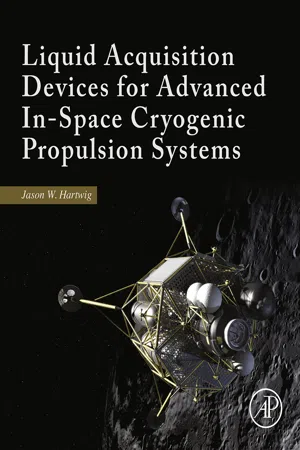The purpose of this chapter is to give an overview of the primary field of application for this work, namely in-space cryogenic propulsion systems. First, the current path of cryogenic propulsion technology development is outlined. Next, the four primary cryogenic fluids of interest are briefly examined in terms of physical properties to familiarize the reader. Then, existing challenges when working with cryogenic fluids are discussed as well current mitigation strategies. Finally, cryogenic propellant engines and cryogenic propellant depots are briefly examined to show how cryogenic fluid management devices are required inside the propellant tank, particularly propellant management devices.
1.1 The Flexible Path
Manned space exploration remains at the forefront of mankind's relentless endeavor to search, explore, and thus understand the physical universe. Despite the recent de-emphasis on a single manned mission to the surface of the Moon, the National Aeronautics and Space Administration (NASA), as well as commercial space flight community still maintains strong interest in human and robotic missions beyond low Earth orbit (LEO) environments. A new strategy for human exploration was recently outlined in the Augustine Report, which shifts focus away from a single destination to that of several (Augustine, 2010). Deemed the Flexible Path, travel to several locations of interest will follow a logical progression; NASA will continue to develop the technology necessary to orbit, probe, and eventually land on several celestial bodies of interest through an increase in research and funding to relevant technologies in the coming years (Crawley and Mindell, 2010; Korsmeyer et al., 2010). Inherent in this new focus will be the development, design, and optimization of the primary systems and subsystems of heavy launch lift (HLL) vehicles, LEO vehicles (such as in-space fuel storage and transfer vehicles, satellites, etc.), robotic probes and landers, and eventually, vehicles which could potentially deliver robots and humans to the surfaces of the Moon and Mars.
The logical progression of space exploration begins with developing LEO systems, followed by travel to Earth-Moon Lagrange points, then near Earth objects (NEOs) such as asteroids, followed by robotic satellites to probe the Moon, Mars, and beyond, robotic surface missions, and finally manned surface missions. Necessary for the exploration and study of these locations of interest will be the development of new and existing propulsion capabilities required to send both human and robot afar. Therefore advanced in-space propulsion systems, which are the backbone of any and all space flight programs, will be required regardless of the mission, destination, or desire.
The primary three in-space propulsion systems include electric, chemical, and nuclear systems. The primary measure of the performance of a particular propulsion system is to determine the non-dimensional specific impulse (ISP):
where
is thrust,
is the total mass flow rate of propellant, and
g is gravity. ISP provides a convenient method to compare efficiency of different propulsion systems. For example, electric propulsion systems generally have very high ISP and low thrust relative to chemical and nuclear systems, which makes them best suited for long duration robotic missions where human life support systems are not required. However, for long duration manned missions, electric systems may not be able to provide adequate thrust to propel humans to the final destination in a reasonable time. Comparatively, chemical and nuclear systems are generally characterized by lower ISP, but much higher thrust relative to electric systems. Emphasis in the current work is on general cryogenic propulsion technology development of cryogenic fluid management (CFM) components, which has applications for both chemical and nuclear systems because long-term storage and transfer of cryogenic liquids is required for both systems.
According to NASA's long-term space exploration vision, the development of cryogenic propulsion systems remains at the forefront of its research and technology development program (NASA's Space Technology Roadmaps, 2012). Cryogenic propellant technology can be used to enable future high performance in-space engines, fuel storage depots (defined in Section 1.6.2), life support systems, fuel cells, in-space resource utilization (ISRU) systems, cooling, refrigeration, liquefaction, and will thus enable every one of the aforementioned missions and destinations of interest. The challenge thus arises to develop technology that is flexible, broad based, and applicable to multiple missions under the Flexible Path, rather than applicable to a single mission. In addition, fundamental issues associated with the storage and transfer of cryogenic propellants must first be addressed before any of these missions become fully realizable.
1.2 Fundamental Cryogenic Fluids
In physics, the field of cryogenics is loosely defined as the study of physical phenomena that occur at very low temperatures. A cryogenic liquid is therefore defined as a substance which exists as a liquid at extremely cold temperatures and a gas at room temperatures. However, “low” and “cold” are relative words since all substances can be evaporatively cooled into a liquid and then solid state, with the exception of helium. Liquid nitrogen (LN2) is generally used as the standard reference cryogenic liquid, since nitrogen exists in abundance on Earth, and because the normal boiling point (NBP) of 77.4 K is very low relative to many substances which exist as liquids at room temperature.
This work is focused on the general field of cryogenic liquid flow through porous liquid acquisition devices (LADs). Regardless of the temperature regime, the liquid state is always bound by the triple point, the point at which a liquid begins to solidify into a solid, and the critical point, the point at which liquid and gaseous phases become indistinguishable. Outlined in Figure 1.1 are the four primary fundamental cryogenic liquids: liquid ...



